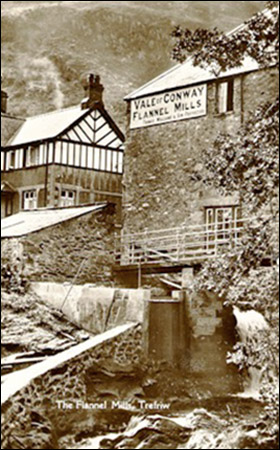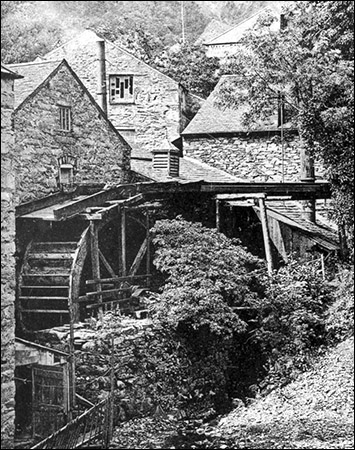Trefriw Woollen Mills
The complex of mill buildings and machinery at Trefriw upholds a long tradition of wool processing and weaving in northern Snowdonia. This was once a cottage industry, with families spinning and weaving wool in their homes and taking the cloth to local fulling mills for washing and finishing.
 The Industrial Revolution allowed mechanisation of many of the repetitive tasks, and in the early 19th century a water-powered fulling mill was built at Trefriw. This took advantage of the abundant supply of water from the rain-soaked mountains to the west.
The Industrial Revolution allowed mechanisation of many of the repetitive tasks, and in the early 19th century a water-powered fulling mill was built at Trefriw. This took advantage of the abundant supply of water from the rain-soaked mountains to the west.
In 1859 the mill was acquired by Thomas Williams, who moved here from Pentrefoelas and became a county councillor, deacon of Ebenezer chapel and a member of the Geirionydd Education Committee. He died in 1906, leaving a widow, four daughters and two sons. The mill remains in the hands of the Williams family.
The building in the upper photo, taken in the early 20th century, still stands, upstream of the current mill complex. The sign in the picture reads: “Vale of Conway Flannel Mills, Thomas Williams & Son Proprietors.” The company’s products then included shawls, stockings, quilts and rugs, all “made from pure sound Welsh wool”.
The main building at the front of the site was built c.1970 to a design by Colwyn Foulkes & Partners, of Colwyn Bay. It features three roofs with shallow slopes, reminiscent of Alpine architecture. Behind this building is a collection of older mill buildings, which can be viewed by entering the mill yard or following the path alongside the river Crafnant.
 In 1918, workers from Trefriw Woollen Mills won several of the Arts and Crafts prizes at the National Eisteddfod of Wales. Their prize-winning objects included: a piece of fine cream serge, suitable for ladies’ dresses; a piece of white baby flannel; and a pair of double-size blankets.
In 1918, workers from Trefriw Woollen Mills won several of the Arts and Crafts prizes at the National Eisteddfod of Wales. Their prize-winning objects included: a piece of fine cream serge, suitable for ladies’ dresses; a piece of white baby flannel; and a pair of double-size blankets.
The mill still uses a turbine dating from 1947 to generate electricity to drive the machinery, most of which dates from the 1950s and 1960s. The weaving shed and turbine house can be viewed during shop hours. Items for sale in the shop include traditional Welsh “tapestry” (double weave) bedspreads and throws, and cushion covers, bags and purses made up in fabrics woven on site.
In the 19th century there were several industries on the river Crafnant, starting with the forge above the “Fairy Falls”, then two woollen mills with waterwheels, a sawmill (now the old dyehouse) with waterwheel, a flour mill with waterwheel where the new mill building was built in the late 1960s, and (below the village bridge) a factory which made gravestones and hones (stones for sharpening tools). The bottom picture shows the flour mill and waterwheel.
With thanks to the Aneurin and Gladys Hughes photo collection, Trefriw Historical Society
Postcode: LL27 ONQ View Location Map
Website of Trefriw Woollen Mills


